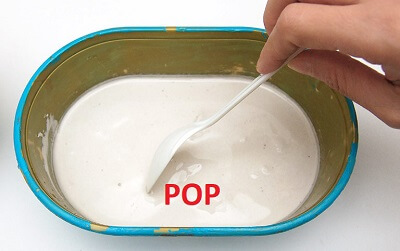Plaster of Paris
Plaster of paris is also known as the Gypsum plaster as it is made of gypsum. It is commonly used to make the false ceiling, as a sculpturing material and in plasters used in the treatment of fractured bones. Its chemical name is Calcium Sulphate Hemihydrate and its chemical formula is CaSO4.1/2H2O.

Formation of Plaster of Paris
It is obtained from gypsum. The gypsum (CaSO4.2H2O) when heated at 373 K loses water molecules and forms plaster of paris. However, half of the water molecule still remains with the plaster of paris so, it is called hemihydrate. The reaction is shown below;
CaSO4.2H2O → CaSO4.1/2H2O + 3/2 H2O
When water is added to POP, it changes itself into a hard substance, this property makes it suitable to be used to make statues, decorative items, etc.
CaSO4.1/2H2O + 3/2H2O → CaSO4.2H2O
If Gypsum is heated at a temperature of more than 373K, it loses all water molecules and thus gets converted into anhydrous calcium sulphate (CuSO4). In this case, it is called dead burnt plaster as it cannot be used like POP by adding water to it.
Properties of Plaster of Paris
- It is a non-combustible and non-inflammable white powder.
- Although it is chemically less reactive, it can act as an oxidising agent.
- At high temperatures, it undergoes decomposition to produce poisonous sulphur dioxide.
- It changes into a hard mass when it is wet or water is added to it. For example, it forms gypsum crystals (hard mass) when water is added to it.
- It is water-resistant in nature, so it is widely used for making pottery and medical casts.
- It tends to expand slightly after setting.
- At a temperature of more than 373 K, it forms anhydrous calcium sulphate, which is called dead burnt plaster of paris.
Types of Plaster of Paris
There are mainly three types of plaster of paris, which are described below;
- Gypsum Plaster: It is the type of plaster that is discussed above in detail. It is prepared by heating gypsum, so it is known as gypsum plaster.
- Lime Plaster: This type of plaster is made of sand, water and lime. It is also called slaked lime, air lime, etc. A mixture of lime and sand is poured into a mortar mill and water is added to it to make a paste of lime plaster. The properties of lime plaster such as shrinkage, porosity, and strength depend on the amount of sand used to prepare the lime.
- Cement Plaster: It is made of sand, Portland cement, water and suitable plaster. It is applied on both internal and external surfaces of walls of houses. A layer of gypsum plaster is usually added over the cement plaster.
Uses of Plaster of Paris
- In the treatment of fractured bones, it supports and holds the bone in the right position. The bandage is soaked with plaster and then water is added to it, then it is folded over the broken bone and allowed to set into a hard protective coating or orthopaedic cast.
- It is also used to make decorative pieces, statures, and false ceilings. To make a false ceiling, the power is changed into a sheet which is fixed to the roof.
- It is used to fill cracks and gaps in walls and to create ceiling designs in homes, houses, offices and other buildings.
- It does not catch fire, so it is also used as a fireproofing material or used as a coating on wood to prevent fire accidents. It not only protects from fire but also gives an aesthetic finish to the walls.
- In dentistry, it is used to fill the gaps in teeth. For example, when a tooth is removed, the air may enter the affected area, to prevent this the empty space is filled with plaster of paris.
- It is needed to make blackboard chalks, flower vases, toys, decorative items, etc.
- It is also used in funeral homes to recreate damaged body parts and reconnect limbs to dead bodies due to accidents.
- It is an excellent finishing material to give a finishing touch to metals and wood in interior designs.
- It easily adhere to cement walls. So, its coating is applied to cement walls to reduce damage from chemicals and weather.
- In filmmaking, it is used to create big sets of villages, markets, etc.
- It is used as a mould to form tableware such as tea-cup, plate, dinner sets. It helps in providing perfect shapes and sizes to tableware, dishes, bowls, etc.
- It is used in many industries such as it is required for purification of sugar, to make bleaching powder and for tanning.
Although plaster of paris is not harmful, still some precautions must be taken while using it, such as;
- A mask can be worn to prevent the inhalation of powder.
- Wear gloves to avoid skin contact
- Do not wash it down the drain as it can deposit in the drain and may block the drain
- Keep away your hands from the hardening mixtures or do not put your hand in the hardening mixture.
|

 For Videos Join Our Youtube Channel: Join Now
For Videos Join Our Youtube Channel: Join Now









